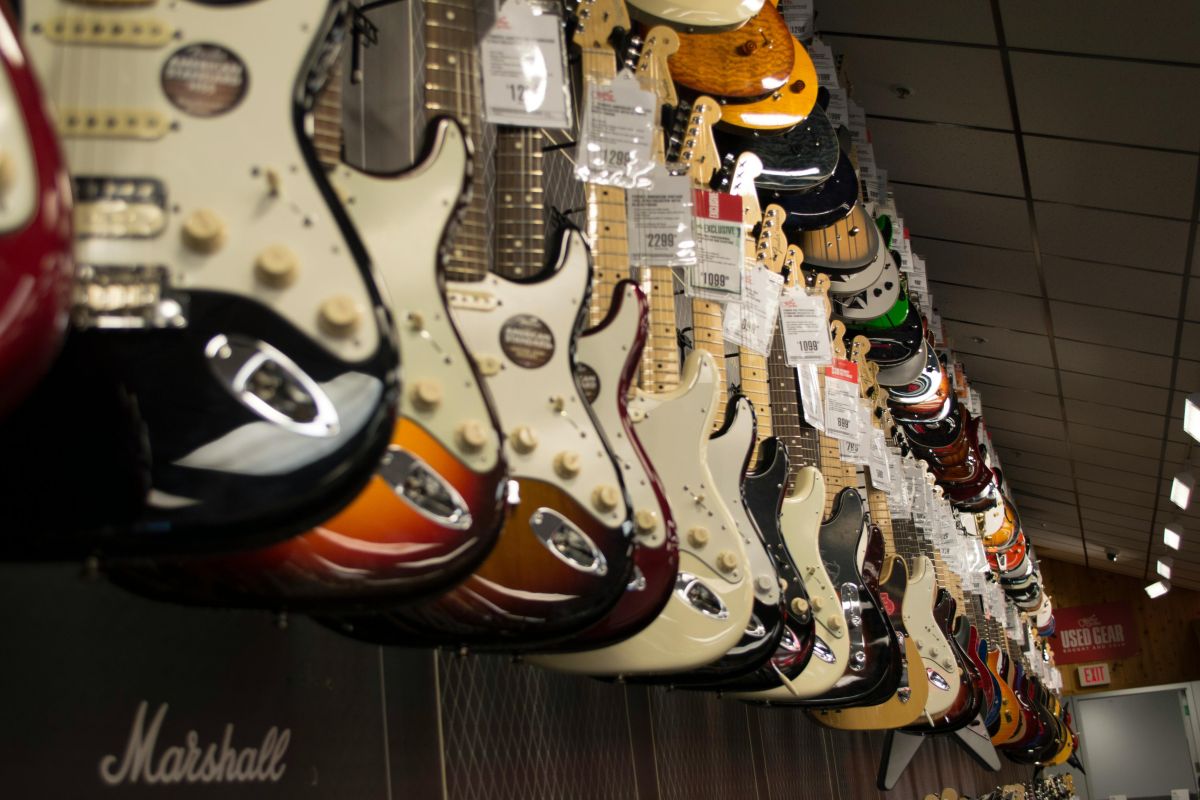Thinking of learning to play the guitar? Then you’re going to need to buy one. Not an easy task if you can't play and have no idea what to look for.
Then you have to consider the price; guitars range from a few hundred dollars to tens of thousands.
Logic dictates that you don’t want a cheap one; they have to be cheap for a reason and will hold you back on your journey to learn the instrument. But, you’re obviously not going to spend thousands and thousands of dollars; that’s just silly.
So, the best bet must be to go for something in the middle.
But is it? Let’s find out, starting with…
Where and How to Buy a Guitar
There are three options for buying your first guitar, and all have their advantages and disadvantages.
Online
The easiest option is to buy online. It couldn’t be simpler. Find something you like the look of at a price you are happy to pay, press ‘Buy’, and it will be delivered straight to your door.
Excellent, you’ve got yourself a guitar, but was it the right choice? You have no idea. You could be lucky and get a great guitar, but on the other hand, you might have ended up with a problem instrument that they just couldn’t sell.
In my experience, if you're buying from a quality store, you should be ok. Check the reviews and the rating, if you spot anything that looks dubious, move on.
On the plus side, you’ll more than likely save money if you buy online. Brick and mortar shops have far more overhead than online stores, so understandably, they are more expensive.
However, guitars sold online are not usually set up well, if at all. This can make them more difficult to play until you go to a luthier and get them set up properly, which can be expensive.
A Guitar Store
As just mentioned, the main difference between buying from a store and online is that you can actually see, touch, and play the instruments. Therefore, guitars have to play well. Who on earth would buy it, if it wasn’t nice to play and didn’t sound ok?
This gives beginners a better chance of getting a very playable guitar. You can also check out how it feels in your hands, if the neck is too big or too small, if it's comfortable on your lap, etc.

The downside, it will be more expensive than the online price.
Some people try and beat the system by going to a store, finding a guitar they like, then going home and buying it online. However, even if you buy the exact same guitar, it might not have the same setup, so when it arrives, it’s off to the local luthier to spend another $50 to $100 on it.
A massive word of advice: If you have a guitar-playing friend, or even a friend of a friend, ask if they’ll come with you to the store to buy the guitar. As long as they’ve been playing for a few years, it will make a massive difference to what you buy.
And the final option is…
Secondhand - Craigslist, Facebook Marketplace, etc.
This is by far the most fun way to buy a guitar and can save you loads compared to the new price. But it isn’t for the faint-hearted and definitely not recommended for beginners.
Having said that, a survey that guitar manufacturing giant, Fender, conducted a few years ago showed that 90% of people who start learning the instrument give up within a year, most within 90 days.
Therefore, there’s always a lot of nearly new guitars on the secondhand market. In most cases, there is absolutely nothing wrong with them - they are simply being sold because the buyer has stopped playing.
Again, if you have a guitar-playing friend who can guide you on the purchase and check the instrument out, and are happy with a used instrument, buying secondhand is a great way to save a lot of money.
Now that you’ve decided on where you’re going to buy the instrument, let’s find the perfect guitar for you.
The Truth about Guitars and Their Prices
You’re looking at various guitars with massively different prices, either online or in a store. But what’s the difference? Why is that guitar 10 times more than that one - they look the same? You can’t see the wood for the trees.
Well, here’s the truth…
Cheap Guitars - $200 to $400
This might come as a shock to most of you, but with the current international standards in guitar building, cheap guitars are, on the whole, more than adequate for a beginner.
That wasn’t the case a few decades ago, but these days, most Asian factories (where the majority of very affordable guitars are built) produce more than acceptable instruments for the money.
Want to Spend a Little More? - $400 to $750
If you’re happy to raise the budget a little, you’ll get a far better guitar. This is the point where you’ll get the most bang for your buck across the whole guitar price range.
These slightly more expensive guitars tend to have higher-quality components throughout, especially the all-important pickups, and are made from better pieces of wood.
This is the price range I recommend for most beginners, with Squier, Epiphone, and Yamaha being great brands to check out.
The Big Leagues - $750 to $5000
Unless money is no object, I wouldn’t spend more than $750 on a first guitar. For example, a Gibson Les Paul Standard - as played by everyone from Jimmy Page to Slash and the dream guitar of many - costs about five times more than an Epiphone Les Paul Standard.

Gibson Les Paul Standard
Is it 5x the Guitar?
Nope, nowhere near. The Gibson is built in America, has better quality workmanship, as well as higher-grade wood and parts. But in terms of playability and sound, I would put it at 15-20% better than the Epiphone, at most.

Epiphone Les Paul Standard
So, you must be wondering why guitarists, including myself, buy them. Well, a 15-20% improvement in sound and playability is a lot more than it seems if you’re a professional or have developed an ear for what a guitar should sound like through years of playing. Therefore, paying five times the price is more than justified.
But for a beginner, it makes absolutely no difference, so go for a more affordable guitar and either upgrade it or buy a higher-end guitar in the future.
However, there are exceptions. For example, if you have a guitar player to guide you, buying a second-hand high-end guitar at the ‘right price’ can be an investment.
Let’s take a look at two dream guitars…
If you were to buy a new Fender Stratocaster or Gibson Les Paul, you would lose about 30% when you sell it. However, if you bought a nice example of either of these guitars on the second-hand market, decided after a few months that this guitar playing lark wasn’t for you, and sold the guitar, you probably wouldn’t lose a penny; you might even make some money.

Fender Stratocaster
It’s worth a thought, as long as you have some spare cash (a few thousand) and someone who knows their stuff to guide you on the purchase.
The Silly Leagues - $5000 and upwards
Guitars costing this much are hand-made from exotic woods, have super intricate inlays, are very limited in number, adding to their rarity value, etc., etc.
They are not meant for beginners, so leave well alone.
Let’s now go back to the original question…
Should you buy an affordable guitar and upgrade it, or just go out and buy a premium one?
If you’ve taken my advice, the answer is easy…
Step #1 - Find yourself a nice guitar in the $400 to $750 range.
Step #2 - Learn to play and see how you get on with the guitar. If you fall in love with it, as so many of us guitarists do, then you probably won’t want to let it go. You might well buy other, more expensive instruments in the future, but you’ll always keep the special one that started your journey.
This is when a lot of people look at upgrading their first guitar to make it even better. Some even upgrade them so much that they are equivalent to or even better than premium instruments. A great example is Steve Rothery from Marillion, whose Squire Stratocaster (which cost him around $200) has been used on countless multi-million-selling worldwide hits.
It’s impossible and probably too early to guide you on particular upgrades, but when you’re ready, the following are well worth checking out:
-
Why the Stratocaster Is the Best Guitar in the World – and How to Improve Yours
-
Why is a Les Paul the best guitar in the world, and how to make yours even better?
-
Why is the Telecaster the Best Guitar in the World, and How to Improve Yours
All the parts you could ever need are available from high-quality aftermarket brands such as Guyker. Check their site out, you’ll be amazed at the options.
However, if you don’t fall in love with your first guitar, the best advice is to sell it and buy a better one in a few years' time. By then, you’ll know what you like and what you don’t, so the decision on what to purchase will be much easier
Wrapping it Up!
There’s never been a better time to learn to play the guitar, and since you now know that your first instrument isn’t going to cost you a fortune, there’s no stopping you.
Get down to your local guitar store or online, check out the options, and buy the instrument that could turn you into a rockstar. You’ll also need to get yourself a good teacher, but there are loads of options these days, both in-person and online, so that shouldn’t be a problem.
Then, in a few years, or maybe before, decide if upgrading your beloved guitar is a good option. In my experience, it always is. After all, buying a new bridge or a high-quality set of tuning machines is a lot more affordable than paying thousands of dollars for a premium guitar!


Share:
Steve Rothery’s Squire Stratocaster - Why does one of Prog Rock's greatest guitarists play a Squire?
Installing Locking Tuners - A Step-by-Step Guide for Better Tuning Stability